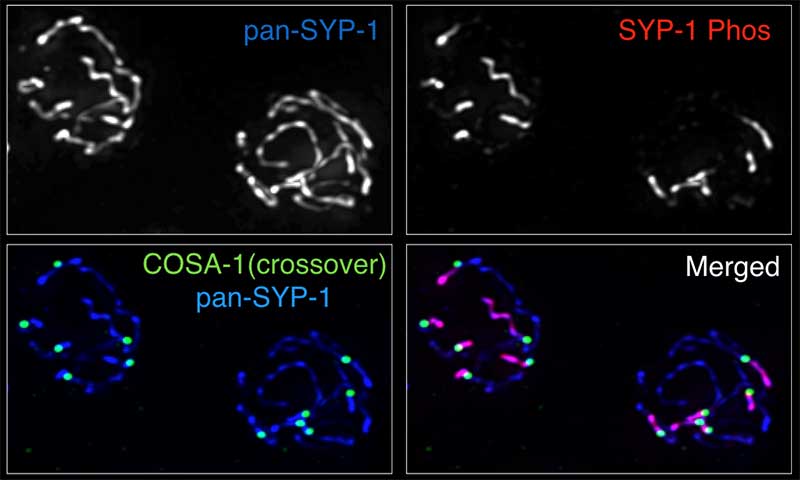Insights gained from the phosphorylation of meiotic protein SYP-1
To produce functional oocytes and sperm, chromosomes must be precisely halved through cell division. This complex procedure is orchestrated by a series of proteins that must localize at the right place and time on chromosomes immediately before cell division. While scientists have so far elucidated some mechanisms that control this activity, many parts remain a mystery.
In a new study, a research group from Kyoto University's Graduate School of Biostudies used the model organism C elegans and found that phosphorylation -- protein coupling with a phosphoryl group -- of protein SYP-1 promotes faithful production of oocytes.
The report shows that phosphorylated SYP-1 guides the placement of other key chromosomal proteins to ensure separation of chromosomes in the meiotic cell division. The findings were published in the Journal of Cell Biology .
In C elegans , SYP-1 is part of a highly conserved protein structure called the synaptonemal complex , which is active only during meiosis and holds homologous chromosomes together before they separate.
In many model organisms, including mammals, some of these synaptonemal complex proteins are known to be phosphorylated during meiosis. However, the biological significance of their phosphorylation in oocytes/sperm production is not fully understood.
The team identified the phosphorylation sites on SYP-1 by applying tandem mass spectrometry analysis on C elegans oocyte precursor cells. They then generated C elegans mutants where SYP-1 could not be phosphorylated and observed its biological response. It was noted that during meiosis in such mutants, key proteins that are required for proper division were not localizing properly on chromosomes, resulting in unequal segregation.
Through further investigation, the researchers were surprised to find that of the twelve initially-identified phosphorylation sites on the SYP-1 protein, only a single site was critical for SYP-1 function.
Roughly 10-15% of couples at childbearing age are estimated to have infertility issues, and in many cases, the cause is not understood. The team hopes that by using the model organism C elegans they can further elucidate the molecular mechanisms behind the faithful production of oocytes and sperm, thereby understanding more about obstacles to human fertility.

Two C elegans oocytes
Top left: All SYP-1 protein. Top right: Phosphorylated SYP-1. Bottom left: Merge of crossover sites (COSA-1) and SYP-1 protein. Bottom right: Merged image of SYP-1 (blue), phosphorylated SYP-1 (magenta), and COSA-1 (green). Phosphorylated SYP-1 are localizing on the short arm of the synaptonemal complex (Kyoto University/Carlton Lab)
Paper information
【DOI】 https://doi.org/10.1083/jcb.201707161
【KURENAI ACCESS URL】 http://hdl.handle.net/2433/228869
Aya Sato-Carlton, Chihiro Nakamura-Tabuchi, Stephane Kazuki Chartrand, Tomoki Uchino, Peter Mark Carlton (2017). Phosphorylation of the synaptonemal complex protein SYP-1 promotes meiotic chromosome segregation. The Journal of Cell Biology, jcb.201707161.





